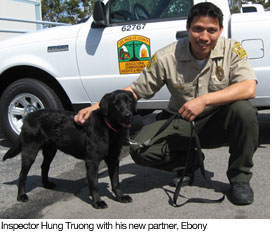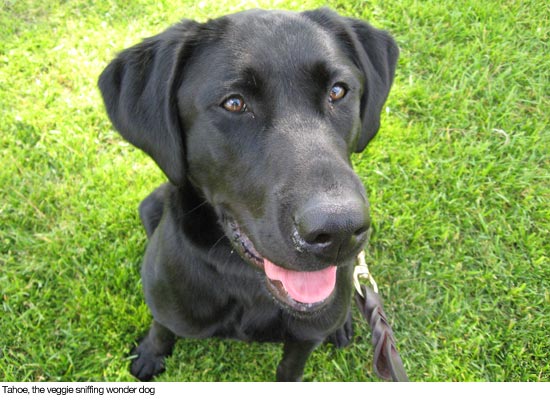Veggie smugglers, beware
March 31, 2010
In L.A. County’s canine workforce, you’ve got your glamour hounds– dogs who can sniff out a multimillion dollar drug cache faster than you can say “film at 11.” And you’ve got your rough-and-ready patrol dogs—the ones renowned for collaring runaway bad guys in mean back alleys.
But where, oh where is that rare breed of dog who can take down a rogue shipment of dandelion greens, bok choy and parsley? To which the county agriculture department says: Meet Ebony and Tahoe.
The new dogs on the beat, together with their handlers, inspectors Hung Truong and Rogelio Carranza, are the pioneering members of the county’s new Agricultural Detector Dog Program.
Truong and Carranza recently traveled to Georgia for a 10-week course at the USDA National Detector Dog Training Center. There, they met their new dog partners and got to work on illicit produce detection.
The training initially involved teaching dogs to scratch at boxes in which handlers had placed five different fruits—guava, mangoes, stone fruit, oranges and apples. Then “non-target boxes”—containing items like clothes, candy and shampoo—were added to the mix, with treats bestowed on the dogs when they continued to scratch at the fruit-filled boxes in the midst of the other packages.
Since February, the team has been on the job in Los Angeles County, conducting inspections at FedEx warehouses and planning to expand soon into UPS and U.S. Postal Service facilities as well.
The stakes are high. An unwelcome pest that hitches a ride on, say, some homegrown peaches could quickly become established here.
“An infestation of such pests could cost California millions of dollars in crop and job losses, increased pesticide use, and quarantines that impact trade,” according to a new brochure on the program.
“The granddaddy of all pests that we don’t want to have infesting this county are the fruit flies,” says Dave Cassidy, quarantine deputy for the Department of Agricultural Commissioner/Director of Weights and Measures. “By stopping it before it even gets here, that’s the cheapest method.”
The effort is being funded with $311,205 in federal money passed along by the California Department of Food and Agriculture—an arrangement approved Tuesday by the Board of Supervisors. The funding covers all expenses associated with the program, including dogs, training and human salaries.
The team already is earning kudos for its work. Ebony, a Lab mix, was prominently featured in a recent pest report put out by the California Department of Food & Agriculture. In the best just-the-facts style of the police blotter, under the headline “LA County’s New Detector Dog Team’s First Find!” it said:
“On March 5, 2010, at about 8:00 a.m. at the FedEx in Santa Fe Springs, Ebony responded to an unmarked box sent from Arizona.
Inspector Truong and supervisor Carmen Rieger opened the unmarked box and found it contained dandelion greens, bok choy, dill, green lettuce, and parsley.”
What sounded like an innocent salad bar became considerably less appetizing when you learned about the garnishes it was carrying.
“The mixed vegetables appeared home grown and contained ants, aphids, mites, slugs, springtails, wasps, and moths. One of the insects was a big-headed ant (Pheidole sp.) which is a Q-rated pest. The shipment’s contents were destroyed by freezing.”
The discovery came as a shock—not least of all to Truong, who thought he was looking at an olive oil shipment.
 As for her compensation for the big find—“We call it ‘Jackpot,’ ” Truong says. “Instead of one piece of treat, we give ‘em four… They’re working for the treat, but they’re also working for us, so we praise ‘em up. I give her belly rubs, too.”
As for her compensation for the big find—“We call it ‘Jackpot,’ ” Truong says. “Instead of one piece of treat, we give ‘em four… They’re working for the treat, but they’re also working for us, so we praise ‘em up. I give her belly rubs, too.”
Tahoe, a purebred Labrador who weighs in at 70 pounds, has been making his share of finds, too, recently detecting an unmarked shipment of leeks coming from Michigan, according to Carranza, his handler.
It’s important work—and something that humans just can’t do. Unless a produce shipment is leaking, smelly, “taped weird,” or “coming from a high-risk area,” human inspectors have to rely on correct labeling to tell them what to inspect, says Rieger, the teams’ supervisor. But with dogs sniffing out the packages—correctly labeled and otherwise—as they come down the conveyor belt, human inspectors can devote more energy to properly investigating what they find.
“I love it,” says Carranza, 49, a 20-year department veteran. “Right now, I think it’s better with my dog. I’m not alone.”
Posted 3/30/10













 405 bridge work causes a stink
405 bridge work causes a stink
